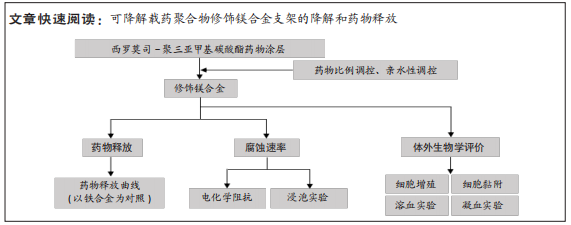[1] HU T, YANG C, LIN S, et al. Biodegradable stents for coronary artery disease treatment: Recent advances and future perspectives. Mater Sci Eng C. 2018; 91:163-178.
[2] ALJIHMANI L, ALIC L, BOUDJEMLINE Y, et al. Magnesium-based bioresorbable stent materials: review of reviews. Journal of Bio- and Tribo-Corros. 2019;5(1):26.
[3] Ma J, Zhao N, Betts L, et al. Bio-adaption between magnesium alloy stent and the blood vessel: a review. J Mater Sci Technol. 2016;32(9):815-826.
[4] 李振宁,杨巍.生物可降解镁合金支架的目前研究和展望[J].心血管病学进展,2021,42(5):425-428.
[5] 刘洪伟,杨涵,吴娟洁,等.生物可吸收支架研究进展[J].中国医疗设备,2021 36(1):171-174,178.
[6] MANAM NS, HARUN WSW, SHRI DNA, et al. Study of corrosion in biocompatible metals for implants: A review. J Alloys Compd. 2017;701: 698-715.
[7] CUBERO-GALLEGO H, VANDELOO B, GOMEZ-LARA J, et al. Early collapse of a magnesium bioresorbable scaffold. JACC Cardiovasc Interv. 2017;10(18): e171-e172.
[8] TOUŠEK P, LAZARÁK T, VARVAŘOVSKÝ I, et al. Comparison of a bioresorbable, magnesium-based sirolimus-eluting stent with a permanent, everolimus-eluting metallic stent for treating patients with acute coronary syndrome: the PRAGUE-22 Study. Cardiovasc Drugs Ther. 2021.doi: 10.1007/s10557-021-07258-z.
[9] 汪荣香,洪立鑫,章晓波.生物医用镁合金耐腐蚀性能研究进展[J].材料工程,2021,49(12):14-27.
[10] 贾东煜,王贵学.血管支架内再狭窄相关因素与机制的研究进展[J].中国组织工程研究与临床康复, 2007,11(35):7061-7064.
[11] 刘璐超,娄丽.镁合金的表面处理[J].材料开发与应用,2022,37(1):98-102.
[12] 贾晓萌,侯应龙.冠状动脉支架内再狭窄的治疗进展[J].心脏杂志, 2022,34(3):344-347,351.
[13] VESGA B, HERNANDEZ H, MONCADA M, et al. Three-month evaluation of strut healing using a novel optical coherence tomography analytical method following bioresorbable polymer everolimus-eluting stent implantation in humans: the TIMELESS study. Coron Artery Dis. 2017;28(2):126-134.
[14] LI LY, CUI LY, ZENG RC, et al. Advances in functionalized polymer coatings on biodegradable magnesium alloys - A review. Acta Biomater. 2018;79:23-36.
[15] OTSUKA F, CHENG Q, YAHAGI K, et al. Acute thrombogenicity of a durable polymer everolimus-eluting stent relative to contemporary drug-eluting stents with biodegradable polymer coatings assessed ex vivo in a swine shunt model. JACC Cardiovasc Interv. 2015;8(9):1248-1260.
[16] 公锐,裘淼涵,李子琪,等.急性冠状动脉综合征患者植入生物涂层可降解支架与永久涂层药物洗脱支架临床结局比较:一项单中心真实世界研究[J].临床军医杂志,2021,49(10):1070-1073,1078.
[17] WANG J, HE Y, MAITZ MF, et al. A surface-eroding poly(1,3-trimethylene carbonate) coating for fully biodegradable magnesium-based stent applications: toward better biofunction, biodegradation and biocompatibility. Acta Biomater. 2013;9(10):8678-8689.
[18] GAYLE J, MAHAPATRO A. magnesium based biodegradable metallic implant materials: corrosion control and evaluation of surface coatings. Recent Pat Corros Sci. 2019;9(1):3-27.
[19] LIU X, ZHEN Z, LIU J, et al. Multifunctional MgF2/polydopamine coating on Mg alloy for vascular stent application. J Mater Sci Technol. 2015;31(7):733-743.
[20] MAO L, ZHU H, CHEN L, et al. Enhancement of corrosion resistance and biocompatibility of Mg-Nd-Zn-Zr alloy achieved with phosphate coating for vascular stent application. J Mater Res Technol. 2020;9(3):6409-6419.
[21] CHEN S, WAN P, ZHANG B, et al. A novel polymer critical re-melting treatment for improving corrosion resistance of magnesium alloy stent. J Mater Sci Technol. 2019;35(1):19-22.
[22] PAN CJ, TANG JJ, WENG YJ, et al. Preparation and in vitro release profiles of drug-eluting controlled biodegradable polymer coating stents. Colloids Surf B. 2009;73(2):199-206.
[23] LI JA, CHEN L, ZHANG XQ, et al. Enhancing biocompatibility and corrosion resistance of biodegradable Mg-Zn-Y-Nd alloy by preparing PDA/HA coating for potential application of cardiovascular biomaterials. Mater Sci Eng C. 2020;109:110607.
[24] DING W, ZHAO Z, JIANG L, et al. Preparation and evaluation of a UV-curing hydrophilic semi-IPN coating for medical guidewires. J Coat Technol Res. 2021;18(4):1027-1035.
[25] GNEDENKOV AS, LAMAKA SV, SINEBRYUKHOV SL, et al. Control of the Mg alloy biodegradation via PEO and polymer-containing coatings. Corros Sci. 2021;182:109254.
[26] LIU S, ZHAO X, TANG J, et al. Drug-eluting hydrophilic coating modification of intraocular lens via facile dopamine self-polymerization for posterior capsular opacification prevention. ACS Biomater Sci Eng. 2021;7(3):1065-1073.
[27] WEI Y, ZHANG J, ZHANG Y, et al. Construction of controllable polyethylene glycol bioactive coating with hemocompatibility from the surface of modified glass substrate. Sheng Wu Yi Xue Gong Cheng Xue Za Zhi. 2019;36(2):260-266.
[28] 李崇渔,沈迪,韦文宁,等.血小板体外粘附试验的临床意义[J].中华内科杂志,1982,21(9):558.
[29] 赵琪,冉峰.药物涂层支架的研究进展[J].中国血管外科杂志(电子版), 2017,9(2):156-160.
[30] MCKITTRICK CM, CARDONA MJ, BLACK RA, et al. Development of a Bioactive Polymeric Drug Eluting Coronary Stent Coating Using Electrospraying. Ann Biomed Eng. 2020;48(1):271-281.
[31] 凌浩,王宝,吴莉侠,等.依维莫司药物洗脱支架的发展进程[J].中国组织工程研究,2019,23(6):978-984.
[32] LU P, FAN H, LIU Y, et al. Controllable biodegradability, drug release behavior and hemocompatibility of PTX-eluting magnesium stents. Colloids Surf B. 2011;83(1):23-28.
[33] XU W, YAGOSHI K, KOGA Y, et al. Optimized polymer coating for magnesium alloy-based bioresorbable scaffolds for long-lasting drug release and corrosion resistance. Colloids Surf B. 2018;163:100-106.
|







